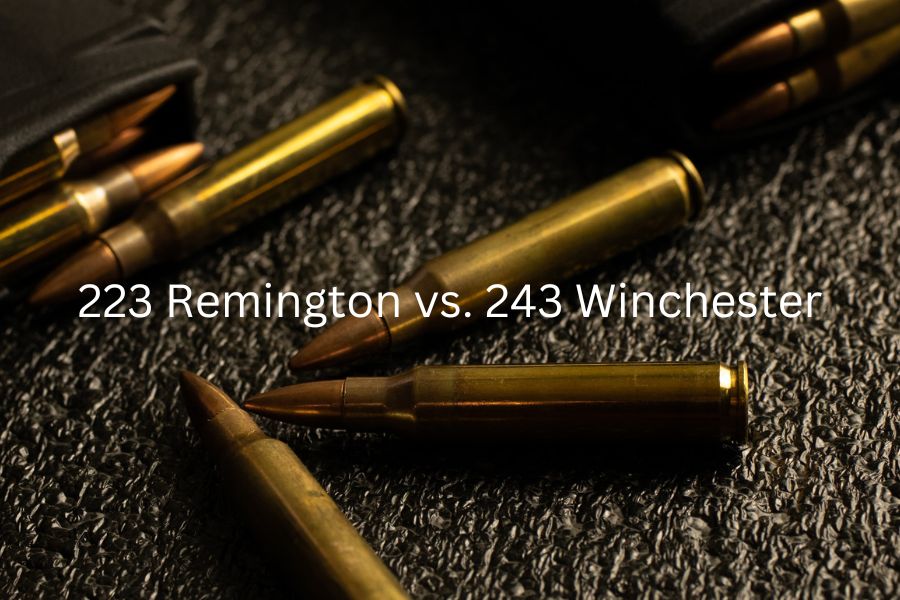When it comes to rifles, choosing the right cartridge is crucial. Two popular cartridges among hunters and shooters are the 223 Remington and 243 Winchester. While both cartridges have their unique strengths and weaknesses, they are often compared for their effectiveness on varmints and small game. In this article, we’ll dive into an in-depth comparison of the 223 Remington and 243 Winchester, so you can make an informed decision about which cartridge is right for you.
Here is the short answer:
The 223 Remington is a smaller caliber cartridge, typically fired from an AR-15 style rifle. The 223 has a flat trajectory and is very common but is lacking in energy. The 243 is a more powerful cartridge typically fired out of a bolt action rifle and is better for big-game hunting.
There is a lot more to compare the 223 to the 243 than just the short answer like an in-depth look at each caliber, each cartridge’s ballistics, and how the two cartridges compare in-depth.
In-Depth Look at the 223 Remington
The 223 Remington was developed in 1957 by Remington Arms for the U.S. military as a replacement for the .308 Winchester cartridge. It is a small caliber cartridge that is commonly used in AR-15 style rifles for varmint and small game hunting. The 223 Remington typically fires a 55-grain projectile at a muzzle velocity of around 3,200 feet per second. This gives it a relatively flat trajectory, making it easier to hit targets at shorter ranges.
One of the primary advantages of the 223 Remington is its light recoil. This makes it easier to shoot accurately and quickly, which is important for hunting varmints and small game. The 223 Remington is also a relatively inexpensive cartridge, which makes it a popular choice for target shooting and plinking.
However, the 223 Remington does have some limitations. Due to its smaller caliber, it is less effective at longer ranges and is not recommended for hunting larger game. Additionally, the 223 Remington has a tendency to over-penetrate, which means that the projectile can pass through the target and continue traveling, potentially causing damage to unintended targets.
Here is a ballistics chart of the 223 Remington with a 55-grain jacketed soft point:
| range (YD) | drop (IN) | wind drift (IN) | velocity FPS | energy ft-lb |
| 0 | -1.5 | 0 | 3240 | 1282 |
| 50 | -0.3 | 0.3 | 3053 | 1138 |
| 100 | 0 | 1 | 2874 | 1008 |
| 150 | -0.8 | 2.3 | 2701 | 891 |
| 200 | -2.7 | 4.3 | 2536 | 785 |
| 250 | -6 | 6.9 | 2376 | 689 |
| 300 | -10.9 | 10.2 | 2222 | 603 |
| 350 | -17.5 | 14.4 | 2074 | 525 |
| 400 | -26.1 | 19.4 | 1931 | 455 |
| 450 | -37.1 | 25.4 | 1795 | 393 |
| 500 | -51.1 | 32.7 | 1667 | 339 |
In-Depth Look at the 243 Winchester
The 243 Winchester was introduced in 1955 by Winchester as a cartridge for hunting medium-sized game, such as deer and antelope. It is a larger caliber cartridge than the 223 Remington, typically fired from a bolt-action rifle. The 243 Winchester typically fires a 100-grain projectile at a muzzle velocity of around 3,000 feet per second. This gives it a longer effective range than the 223 Remington and makes it more suitable for hunting medium-sized game.
One of the primary advantages of the 243 Winchester is its versatility. It can be used for both varmint and medium-sized game hunting, making it a popular choice among hunters. Additionally, the 243 Winchester has a heavier projectile than the 223 Remington, which gives it better stopping power and makes it more effective at longer ranges.
However, the 243 Winchester does have some drawbacks. Due to its heavier recoil, it can be more difficult to shoot accurately and quickly, especially for novice shooters. Additionally, the 243 Winchester is a more expensive cartridge than the 223 Remington, which can make it less accessible for some shooters.
Here is ballistics chart of the 243 Winchester with a 100-grain soft point bullet:
| range (YD) | drop (IN) | wind drift (IN) | velocity FPS | energy ft-lb |
| 0 | -1.5 | 0 | 2960 | 1945 |
| 50 | -0.2 | 0.2 | 2826 | 1774 |
| 100 | 0 | 0.9 | 2697 | 1615 |
| 150 | -1 | 2 | 2571 | 1467 |
| 200 | -3.3 | 3.6 | 2448 | 1331 |
| 250 | -7 | 5.7 | 2329 | 1204 |
| 300 | -12.4 | 8.4 | 2213 | 1087 |
| 350 | -19.6 | 11.8 | 2101 | 980 |
| 400 | -28.7 | 15.8 | 1991 | 880 |
| 450 | -39.8 | 20.3 | 1885 | 789 |
| 500 | -53.6 | 25.9 | 1783 | 706 |
In-Depth Comparison
When it comes to recoil, the 223 Remington is known for being a very mild recoiling round. This makes it a great option for newer shooters and those who want to shoot for extended periods without fatigue. On the other hand, the 243 Winchester has more recoil than the 223, but it is still a very manageable round for most shooters. The 243 Winchester is more powerful than the 223 Remington, which makes it a better choice for medium-sized game.
In terms of accuracy, both rounds are capable of excellent accuracy. However, the 243 Winchester has a reputation for being a very accurate round, especially at longer ranges. This is due to the fact that the 243 has a higher ballistic coefficient than the 223, which means it has less air resistance and therefore less drop and drift over distance.
When it comes to bullet selection, the 223 Remington has a wide variety of bullet options available, ranging from 35 to 90 grains. This makes it a versatile round that can be used for a wide range of applications, from varmint hunting to target shooting. The 243 Winchester also has a wide variety of bullet options, ranging from 55 to 115 grains. However, it is better suited for hunting and long-range shooting due to its higher power and accuracy.
In terms of cost, the 223 Remington is generally less expensive than the 243 Winchester, due to the fact that it is a more common round and is used for a wider range of applications.
Conclusion
In conclusion, the 223 Remington and the 243 Winchester are both great rounds that have their own unique strengths and weaknesses. The 223 is a mild recoiling round that is versatile and affordable, while the 243 is a more powerful and accurate round that is better suited for hunting and long-range shooting. Ultimately, the choice between these two rounds will depend on the shooter’s specific needs and preferences.

